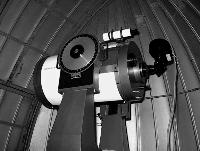Our New Telescope
Everyone at Frosty Drew Observatory is excited as the installation of our new Meade 16 inch Schmidt-Cassegrain telescope approaches. We hope to have it operational in September. The light grasp of the new telescope is five times our current 7 inch refractor. The telescope contains a computer that finds and tracks more than 64,000 sky objects. With the help of an auxiliary personal computer running Hubble Data Base software this jumps to 19,000,000 objectsWhen our telescope is installed it will look like this telescope at Brown University atop the Barus and Holley Building. Precision motors turn the optical system in three dimensions. The whole unit turns left/right. The barrel tilts up/down. Instruments and eyepieces rotate both ways. All of these motions are coordinated by the computer located in the pedestal. Any object which does not move excessively fast across the field of view can be tracked by this system. Even Earth satellites can be tracked, a feat beyond most telescopes.The dark cylindrical object with attached cable is a Charged Couple Display (CCD). CCD imaging systems are far more sensitive than either film or the human eye. Our telescope can see objects many times dimmer than film or eye. The CCD is more than just a sensitive TV camera. It can adjust the telescope to keep a selected object centered. With the CCD on, the sensitivity of our telescope increases an additional factor of 16. CCDs take exquisitely colored pictures of planets, galaxies and nebulae. CCDs have all but replaced film and eyepieces in major research establishments but we will continue to look through eyepieces. Nothing quite matches the experience of seeing something with your own eyes.With its flip/flop prism system, the CCD and a person can share the telescope. While people wait their turn for the eyepiece they can watch the monitor. We will point things of interest at the monitor before you look for them in the eyepiece. Computerized location and tracking will speed switching between objects. This will give each visitor more time at the eyepiece. On partially cloudy nights, automated locating will allow us to start viewing the instant the clouds break. Remote focusing will sharpen images for everyone, not just those blessed with excellent vision. The telescope is so fully automated that it can run remotely over the Internet. We can control and view with the telescope anywhere in the world. All that prevents us from doing this is that our dome lacks automated steering controls. Until such time as we buy such controls, someone must be in attendance to open the shutter and turn the dome as the telescope moves.Unavoidably there will be a period of about two weeks when the dome and its contents will be under construction. We will remain open clear Friday nights using our member's own telescopes. We'll have a First Light Party, open to the public, to celebrate the official reopening of our with its new telescope. The date, time and details of the First Light Party will be posted at both our web site and our bulletin board in Ninigret Park. You can keep up with our progress at www.frostydrew.org. We hope you'll join us to help us celebrate.Early July presents an unusual grouping of the planets on the same side of the Sun. We'll be able to see Mercury set just after sunset, followed by Venus. Mars will be overhead at dusk. Pluto will be in the south eastern sky throughout the evening. Uranus and Neptune will be rise as Venus sets. By 1 AM Saturn and Jupiter will rise and for those afflicted by incurable insomnia, the crescent Moon will rise shortly after 3 AM. Very few people have ever seen the grand slam, all the planets in a single evening. As if this weren't enough, the asteroids Vesta, Juno and Ceres will also be up. If Friday July 9th doesn't work out Friday July 16th will be almost as good.If planets aren't your specialty, there will be some wonderful deep space objects as well. Lets start with the most beautiful double star in the sky - Albireo. One star is a topaz color, the other is a aquamarine blue. There are six or seven marvelous clusters and nebulae in the constellation Sagittarius alone. M8 the spectacular Lagoon Nebula is an all time favorite. My special favorite is M54. It looks like an ordinary star cluster but it is so much more. M54 is the wreckage of a small galaxy that moved too close and was torn apart by our own Milky Way Galaxy. Up above us, Hercules has the spectacular star cluster M13. Over to the East, just below Vega is Lyra with its famous Ring Nebula [M57], the remains of an exploded star. We may be able to make out the pulsar which powers this spectacle.
- Author:
- Leslie Coleman
- Entry Date:
- Jun 1, 1999
- Published Under:
- Leslie Coleman's Columns


